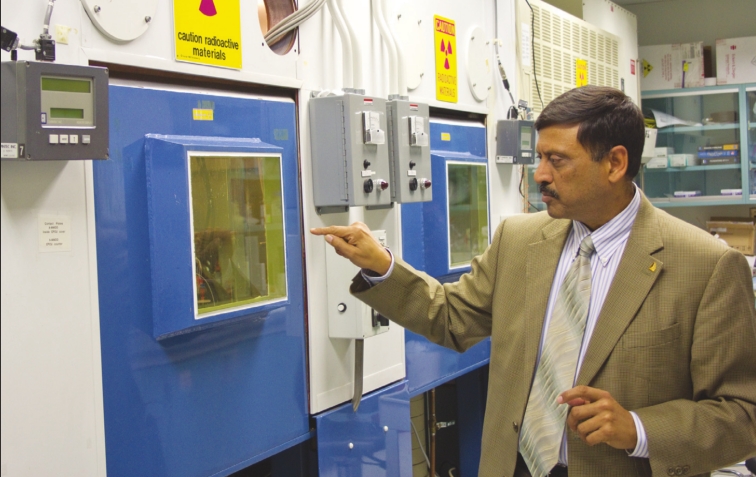Biomedical Research Foundation sets goal to advance local medical technology

[Editor’s Note: At 12:01 a.m. on Oct. 1, 2013, LSU Medical Center in Shreveport and E.A. Conway Medical Center in Monroe undertook a new operating agreement transforming the institutions from public to private companies. Without changing the basic care giving functions, the new entity operates as University Health, administered by the Biomedical Research Foundation Trust. This is the first of a series of articles on new projects and initiatives that University Health is supporting through the ownership of LSU Health.]
A PET project at the Biomedical Research Foundation in Shreveport is anticipated to bring huge benefits to the area, according to the scientists and entrepreneurs who have been working on it.
PET is the acronym for proton emission tomography. For the specialists exploring its capabilities, it is an exciting era of discovery.
Jay Meyers is the vice president for external affairs at BRF. He said with legislative assistance, BRF worked with the Department of Energy to pioneer research and development of PET technology. The journey began in 1995 when the institute began work on its first cyclotron.
A cyclotron is a huge machine that accelerates particles to study their interaction. In a medical application, scientists use the technology to study disease on a molecular level. The need to understand human disease in this way helped create the Center for Molecular Imaging and Therapy.
Meyers said the need alone was not enough; the project needed guidance.
“About three years ago we started figuring out what’s next. What could we do next? We hired [Dr. Pradeep Garg] to be our consultant. He and his wife [Dr. Sudha Garg] are two of the most preeminent scientists in the molecular imaging field.”
Pradeep Garg is the executive director of the CMIT. He explained the difference of PET from the more familiar MRI and CT scans. “MRI and CT scans are anatomical imaging,” he said. “[They] tell where the different body parts are inside your body and where the boundaries are. If there is a tumor, how big or small it is. There are some places where MR and CT don’t give you all the information you need.”
Pradeep Garg said the PET technology began to develop about 30 years ago.
“The big difference is PET doesn’t just tell you the anatomic structure, it tells you the metabolic function of each tissue,” he said. “That means a physician not only can observe a patient’s heart without surgery, he can also determine how efficient the heart’s action is.”
It does that, he said, by looking at metabolic function. The body’s cells burn energy in order to grow. Scientists can observe how average cells metabolize the food we eat. When the cells metabolize in a way that’s unusual, it’s a warning sign for physicians. PET makes it possible for doctors to see those warning signs much earlier than previously possible.
The PET studies are not just about disease, either. Pradeep Garg said the technology is providing valuable clinical insights to scientists studying drug and nicotine addiction as well as traumatic brain injury and concussions.
What this means for BRF is greater opportunity, Pradeep Garg said. The center is already providing the material PET scans require to doctors, clinics, hospitals and research centers across the region. What started as research into how to make people well faster is becoming big business, too.
“We’ve looked ahead and seen that PET could be a technology that’s set to explode,” Meyers said. “If we could be on the front end then [pharmaceutical companies]
will come to us.” Meyers said BRF CMIT will be able to test drug
action, how effective it is and its safety. The process of getting a new
drug through the FDA approval process now takes years. Shortening that
approval period means getting a life-saving or altering drug to market
sooner, improving patient results. As Pradeep Garg said, it also means
the drug companies will get to start getting a return on their
investment sooner. The early days of a drug’s existence are the most
profitable, he said. Meyers added, “When the drug comes to the market we
could manufacture it so that our population here can take advantage of
it.”
All those hopes
depend on preparation, and Pradeep Garg said that’s why his new job
excites him. “My hat’s off to BRF because they thought about it three
years ago. They had the vision to think where the program needs to go.
We need to be excelling in science, research and development.”
“Over the next five years, we’re going to spend between $15 and $20 million in equipment and personnel,” Meyers said.
“On
the economic development side just from the BRF perspective, we’re
going to add about 35 jobs. Because we now have the Gargs, we have the
ability to expand our services. All of this will be available for our
physicians locally and regionally and for scientists to do their
research in higher education. It’s going to ramp up the whole research
effort. We think we have a really cool opportunity here to make a
significant impact on health care.”
Pradeep
Garg said the economic impact was secondary to the medical importance
of the work. “Just hiring 35 new people is not the goal of our program.
It gives the option to local physicians that they can detect disease
that they could not before.” He said local educators at all levels would
be encouraged to adapt their curricula to produce candidates for these
research and manufacturing positions. Those candidates would be in areas
like radio chemistry, pharmacology, chemistry, nuclear medicine,
mathematics and more.
Pradeep
Garg said the goal was to create the future by discovering it. “We need
to stay ahead of the curve – to see the upcoming disease that’s
important in the next 10 years. That’s where our program intends to go.”
– Joe Todaro